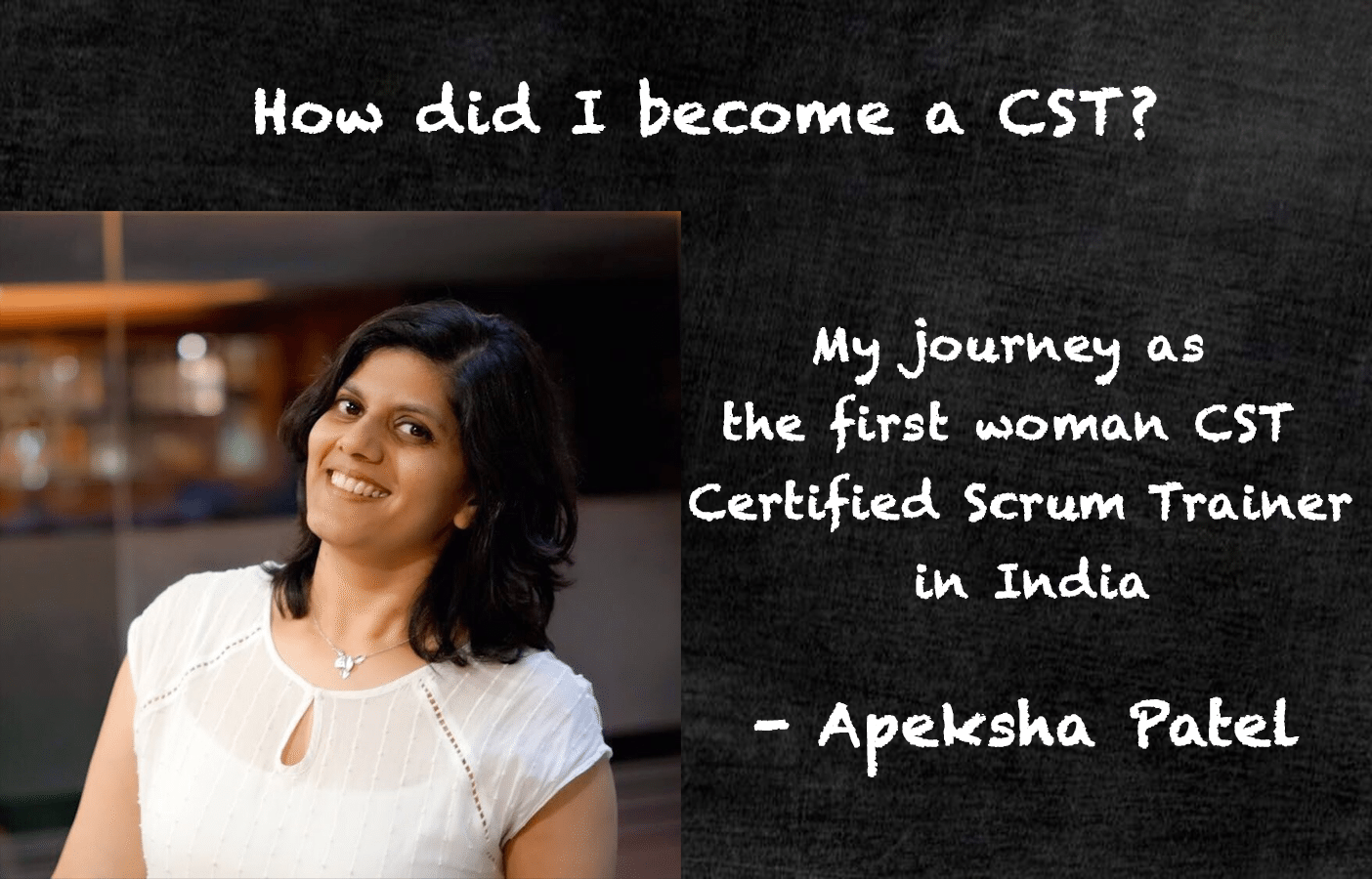How to become a Certified Scrum Trainer (CST®) Apeksha Patel
Apeksha Patel
1st Mar, 2019
“I just heard you became a CST. How do you feel?”
“Since when have you been working towards it?”
“How many recommendations did you have?”
“How many co-trainings did you do?”
“How was the interview with the TAC? Was it scary, or smooth? Were you nervous? What did they ask?”
“Were you able to go through it in one go?”
“How was the experience? Good, Bad, Ugly?”
“How did you become a CST? Is it easy, tough?”
“What made you want to be a CST?” and many more such questions I have encountered since I became a CST. I am not a big-time – or a small-time blogger. But here’s the thing right; a lot of folks do have these questions and I thought – Wouldn’t it be a good idea for people to get to know the first-hand experience from a CST?

So here I am, to share My Journey to becoming a CST.
1. Understand your Purpose
For any venture you start, it is important to know the purpose behind it.
“Why am I doing it?”
“How would it help?”
For me, it never started with becoming a CST. I had seen the benefits of using Scrum in my experiences and was heavily involved in the community to spread the benefits of the same. My vision was always to help people, to share my knowledge and learnings with others so that they too can reap the benefits of Scrum. While working with the community, I realized that there are lots of wrong sources of Scrum mushrooming in the industry and the internet, which is causing a lot of harm. That’s when I made up my mind to make sure I can create that visibility and make people aware of the Spirit of Scrum.
Once you have identified your purpose to becoming a CST, Commit to it. Don’t look around for shortcuts. Don’t get diverted looking for easier options – “So, what if I cannot become a CST, I will become some other trainer”. That’s not committed and that would not get you anywhere.
2. Get Real Experience
I strongly believe that to be an effective trainer, I should believe in what I am teaching. It is not about beautiful graphs and charts and slides – not that they are bad – but it is about sharing experiences – experiences that help people relate to their reality. Otherwise, it is just one of the other things that get said, written, and forgotten. My vision is to generate value for the participant, and I can do that when they can relate to what I say.
So how did I get experience? The simple and straightforward way is to get real hands-on experience. Experience does not mean you have to have the title of ScrumMaster, Product Owner, or Developer. These are not titles – these are roles. You have to tap into your skills and focus on what is an effective role for your skillset.
I started my career as a developer in the Service based industry, moved to Product based companies in IT and later IT/Mechanical Engineering domain continued as a Developer before venturing into the ScrumMaster role, then continued that journey to a Financial based organization and learned a lot from those experiences. I’m continuing this journey being part of building our own products (leanGears) and coaching organizations to achieve agility as part of (leanpitch).
So get there, deep dive into your work, and get hands-on knowledge.
3. Get a Coach
Everyone needs a Coach, to get feedback, improve, to get different perspectives. So did I. My coach never told me what to do but created visibility and clarity. So, how did I go about getting the coach? ScrumAllianceis there to help. On their website, there is a list of Trainers (CST) / Coaches who are open to mentoring. Now again, just because they are open to co-training, does not mean one should go randomly ask someone to become their coach, co-training or vouch a recommendation or become a mentor. There is a lot of groundwork to be done before even thinking about co-training.
I was very clear about my purpose. I connected with the ScrumAlliance trainers to see how they can help. At this point in time, I was looking for mentorship or coaching. After communicating with a few trainers, one of them agreed to be my coach based on conversations, discussions, and my purpose. That helped me immensely. Mind you – at this stage, it was not about co-training or recommendation at all. It was about understanding the reality of the work, and what change in the world of work I was trying to bring. Grooming a Coach and Grooming a Trainer is an extremely benevolent initiative now started by the PlayScrum Community which helps prospective Coaches and Trainers in this area of need.
That brings me to the next step in my journey.
4. Get involved in the community
So how do I know what change I want to bring to the world of work? That’s when the stepping stone we talked about comes into the picture – My “real” experience that led me to my “purpose”.
I have spoken at multiple conferences including Global Scrum Gatherings, Agile Prague, Cognizant, Agile Chandigarh, etc. but I have worked most extensively with PlayScrum Community. This community made me realize the importance of smaller, more focused groups with a purpose of no other benefit other than learning, gaining, and sharing knowledge. Learning from fellow PlayScrum community members, their experiences enriched my knowledge and helped me validate my purpose – am I going in the right direction? Am I trying to solve the right problem? Are people finding “value” from knowledge sharing? I understood the pain points, gave (shared), and gained knowledge from the community. That’s how I improved. That’s how I recharged myself.
As I always say, there is no “Nirvana” stage, I continue to improve even now. PlayScrum Community in open to all who want to join and learn. We have one meetup every weekend across Delhi, Vadodara, Ahmedabad, Mumbai, Pune, Bangalore, and Chennai.
5. Prepare your material
Prepare your own material. Material Guidelines and Learning Objectives are mentioned very clearly and in detail on the ScrumAlliance website.
And I re-iterate – “prepare your own material”. Copying from “anywhere” is not going to help. Because it is “your material”.
I created my own material which reflected my ideas, my understanding, and my point of view of mapping the objectives of what knowledge I wanted to impart and how I planned to do that. The material was all about my perspective of what is the real change in the world of work and how I plan to bring it w.r.t to Learning Objectives from ScrumAlliance.
6. Co-Training
The last part is Co-Training. A lot of people feel that co-training is a hassle and is required just to get recommendations. That is absolutely incorrect in my experience. For me, Co-Training was a beautiful experience where I got the best opportunities to see the different ways different trainers teach, their take on things, how they handle questions and their way of facilitation – and learn from them. Every trainer has his/her own way of imparting knowledge and all these experiences are extremely enriching. I wouldn’t be what I am if I did not get the co-training opportunities.
Frankly, I do not remember how many co-trainings I did in total, it was definitely way more than required for a recommendation. But I didn’t run behind recommendations, because that was not the goal. It is just a by-product. I was open to work with my co-trainers even after getting their recommendations. I wanted to learn, learn and learn more. I was open to feedback, open to making mistakes and learning from them. That’s what co-training is for. I got a real taste of how would it be when I would teach the class. I was and am still like a kid – one who always asks questions, absorbs from the surroundings, and always keeps learning.
7. The Process
So, this was my journey, one I officially started two-three years back and achieved on 7th April 2017. I had recommendations from three CSTs and innumerable co-trainings. Contrary to what many would have heard (falsely) that ScrumAlliance and TAC are not cooperative – it is just a myth. Whenever I would ask questions, I would get adequate responses from the ScrumAlliance Staff, all my questions were patiently understood and answered and I genuinely saw their willingness to help me in this journey. The TAC was absolutely amazing, patient, and open to questions, ideas, and experiments. Yes, I was able to go through the TAC in the first go! It was an absolutely amazing experience and I wouldn’t trade it for any other way!
Yes, it's not easy. Yes, it's not a piece of cake, but it is immensely satisfying. Not because I am a CST, but because I enjoy seeing that “Aha!” moment getting reflected on people’s faces, their eyes widening and heads nodding when they connect with what I am saying when people are satisfied at the end of the workshop and they say it generated “value”. I enjoy the time, get energized by their enthusiasm, and learn a lot from all of them I interact with!
Lastly, I would quote a very famous quote from Hindu scriptures – “Geeta” – Phal ki chinta mat kar, Karm kiye ja… That’s my motto – for continuous learning – for there is no “Nirvana” stage.
If you want to learn more about my experiences and learn about Scrum, you can join my classes. Here is the latest schedule Leanpitch CSM workshop write to scrum@leanpitch.com or call : +91-8041614192 , 7358062677
Apeksha Patel is an Entrepreneur and an Evangelist. She is the Co-Founder at leanGears LLC., and director at Leanpitch Technologies Private Limited. She is the first woman Certified Scrum Trainer(CST) in India, the first Accredited Kanban Trainer(AKT) in India, NLP Coach, and Leadership Gift Practitioner. Connect with her on LinkedIn: Apeksha Patel and follow them on Twitter : @apekshapatel
This is just a speck of knowledge on your journey to becoming an expert in the industry. If you have any doubts or require career guidance, feel free to connect with our Industry experts and trainers for 1-on-1 coaching.

You are already a step ahead. Keep learning and growing!

